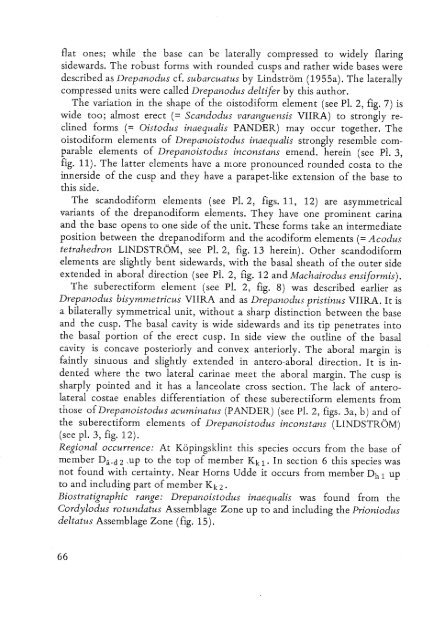UTRECHT MICROPALEONTOLOGICAL BUllETINS
UTRECHT MICROPALEONTOLOGICAL BUllETINS
UTRECHT MICROPALEONTOLOGICAL BUllETINS
Create successful ePaper yourself
Turn your PDF publications into a flip-book with our unique Google optimized e-Paper software.
flat ones; while the base can be laterally compressed to widely flaring<br />
sidewards. The robust forms with rounded cusps and rather wide bases were<br />
described as Drepanodus cf. subarcuatus by Lindstrom (1955a). The laterally<br />
compressed units were called Drepanodus deltifer by this author.<br />
The variation in the shape of the oistodiform element (see PI. 2, fig. 7) is<br />
wide too; almost erect (= Scandodus varanguensis VIIRA) to strongly reclined<br />
forms (= Oistodus inaequalis PANDER) may occur together. The<br />
oistodiform elements of Drepanoistodus inaequalis strongly resemble comparable<br />
elements of Drepanoistodus inconstans emend. herein (see PI. 3,<br />
fig. 11). The latter elements have a more pronounced rounded costa to the<br />
innerside of the cusp and they have a parapet-like extension of the base to<br />
this side.<br />
The scandodiform elements (see PI. 2, figs. 11, 12) are asymmetrical<br />
variants of the drepanodiform elements. They have one prominent carina<br />
and the base opens to one side of the unit. These forms take an intermediate<br />
position between the drepanodiform and the acodifoim elements (= Acodus<br />
tetrahedron LINDSTROM, see PI. 2, fig. 13 herein). Other scandodiform<br />
elements are slightly bent sidewards, with the basal sheath of the outer side<br />
extended in aboral direction (see PI. 2, fig. 12 and Machairodus ensiformis).<br />
The suberectiform element (see PI. 2, fig. 8) was described earlier as<br />
Drepanodus bisymmetricus VIIRA and as Drepanodus pristinus VIIRA. It is<br />
a bilaterally symmetrical unit, without a sharp distinction between the base<br />
and the cusp. The basal cavity is wide sidewards and its tip penetrates into<br />
the basal portion of the erect cusp. In side view the outline of the basal<br />
cavity is concave posteriorly and convex anteriorly. The aboral margin is<br />
faintly sinuous and slightly extended in antero-aboral direction. It is indented<br />
where the two lateral carinae meet the aboral margin. The cusp is<br />
sharply pointed and it has a lanceolate cross section. The lack of anterolateral<br />
costae enables differentiation of these suberectiform elements from<br />
those of Drepanoistodus acuminatus (PANDER) (see PI. 2, figs. 3a, b) and of<br />
the suberectiform elements of Drepanoistodus inconstans (LINDSTROM)<br />
(see pI. 3, fig. 12).<br />
Regional occurrence: At Kopingsklint this species occurs from the base of<br />
member Da-d 2 ,up to the top of member Kk 1. In section 6 this species was<br />
not found with certainty. Near Horns Udde it occurs from member D h 1 up<br />
to and including part of member Kk 2.<br />
Biostratigraphic range: Drepanoistodus inaequalis was found from the<br />
Cordylodus rotundatus Assemblage Zone up to and including the Prioniodus<br />
deltatus Assemblage Zone (fig. 15).
















